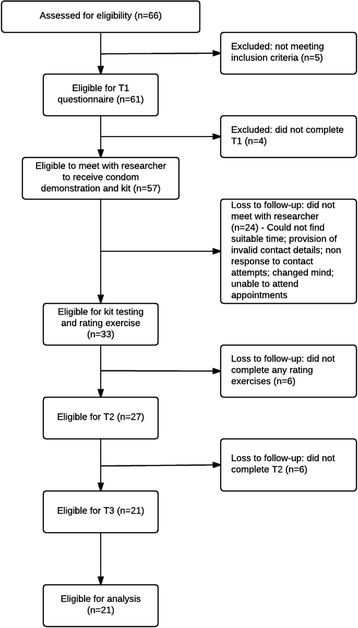Enhancing condom use experiences among young men to improve correct and consistent condom use: feasibility of a home-based intervention strategy (HIS-UK)
- PMID: 29541480
- PMCID: PMC5842531
- DOI: 10.1186/s40814-018-0257-9
Enhancing condom use experiences among young men to improve correct and consistent condom use: feasibility of a home-based intervention strategy (HIS-UK)
Abstract
Background: Condoms remain the main protection against sexually transmitted infections (STIs) when used correctly and consistently. Yet, there are many reported barriers to their use such as negative attitudes, reduced sexual pleasure, fit-and-feel problems and erection difficulties. The UK home-based intervention strategy (HIS-UK) is a behaviour change condom promotion intervention for use among young men (aged 16-25 years) designed to increase condom use by enhancing enjoyment of condom-protected intercourse. The objective of this feasibility study was to test HIS-UK for viability, operability and acceptability. Along with an assessment of the recruitment strategy and adherence to the intervention protocol, the study tested the reliability and suitability of a series of behavioural and condom use outcome measures to assess condom use attitudes, motivations, self-efficacy, use experience, errors and problems and fit and feel.
Methods: The HIS-UK intervention and associated assessment instruments were tested for feasibility using a single-arm, repeated measures design with baseline measurement and two follow-up measurements over 3 months. A 3-month target of 50 young men completing the baseline questionnaire was set. Twenty process and acceptability evaluation interviews with participants and health promotion professionals were conducted post trial.
Results: Of the 61 young men who registered for the study, 57 completed the baseline questionnaire and 33 met with the study researcher to receive the HIS-UK condom kit. Twenty-one young men remained for the duration of the study (64% retention). The Cronbach's alpha scores for the condom use outcome measures were 0.84 attitudes, 0.78 self-efficacy, 0.83 use experience, 0.69 errors and problems and 0.75 fit and feel. Participant and health professional feedback indicated strong acceptability of the intervention.
Conclusions: The feasibility study demonstrated that our recruitment strategy was appropriate and the target sample size was achieved. Adherence was favourable when compared to other similar studies. The condom use measures tested proved to be fit-for-purpose with good internal consistency. Some further development and subsequent piloting of HIS-UK is required prior to a full randomised controlled trial, including the feasibility of collecting STI biomarkers, and assessment of participant acceptance of randomisation.
Trial registration: Research registry, RR2315, 27th March 2017 (retrospectively registered).
Keywords: Behaviour change; Condom; Condom use; Feasibility; Fit and feel; Health promotion; Intervention; Sexual health; Sexually transmitted infections; Young men.
Conflict of interest statement
Approval for the study was obtained from the University of Southampton Ethics Committee (ID: 17504).Not applicableThe authors declare that they have no competing interests.Springer Nature remains neutral with regard to jurisdictional claims in published maps and institutional affiliations.
References
-
- Department of Health . A framework for sexual health improvement in England. 2013.
-
- Public Health England. Sexually transmitted infections and chlamydia screening in England, 2016. Health Protection Report Volume 11 Number 20. 2017. https://www.gov.uk/government/uploads/system/uploads/attachment_data/fil.... Accessed 15 June 2017.
-
- UNFPA. WHO. UNAIDS . Position statement on condoms and the prevention of HIV, other sexually transmitted infections and unintended pregnancy. 2015.
Grants and funding
LinkOut - more resources
Full Text Sources
Other Literature Sources
Miscellaneous


